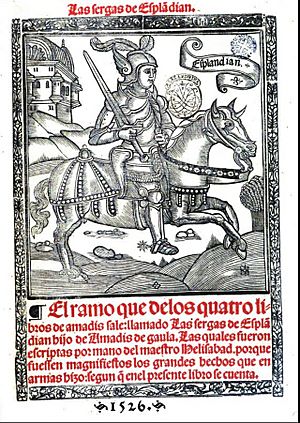Las sergas de Esplandián facts for kids
 |
|
| Author | Garci Rodríguez de Montalvo |
|---|---|
| Country | Spain |
| Language | Spanish |
| Genre | Chivalric romance |
| Published | July 1510 |
Las Sergas de Esplandián (which means The Adventures of Esplandián) is an old adventure novel. It was written by Garci Rodríguez de Montalvo around the late 1400s or early 1500s. This book is a sequel to another very popular series called Amadís de Gaula. Even though some people didn't love its writing style, it became famous in 1862. That's when Edward Everett Hale figured out it was where the name California came from!
Contents
The Story Behind the Book
Garci Rodríguez de Montalvo was a writer from Spain. He first translated and changed an older Portuguese story called Amadís de Gaula into Spanish. The original Amadis had three parts. Montalvo added a fourth part that he mostly wrote himself.
How Esplandián's Adventures Began
After finishing Amadís de Gaula, Montalvo wrote Las Sergas de Esplandián. This new book was all about the exciting adventures of Esplandián. He was the son of Amadis, the hero from the first series. The oldest copy of Las Sergas de Esplandián that we know of was printed in Seville, Spain, in July 1510. People think earlier versions might have been printed even before 1496.
When Was It Written?
Historian Ruth Putnam believes Montalvo finished his novel sometime after 1492. But it was likely before Queen Isabella died in 1504. Montalvo himself is thought to have passed away in 1505. This means some of his books were published after he died.
A Book in Don Quixote's Library
The novel Las Sergas de Esplandián is even mentioned in another famous Spanish book. This is Don Quixote, written by Miguel de Cervantes in 1605. In chapter six, Don Quixote's family and friends decide to burn his books. They think the books are making him act strangely.
Las Sergas de Esplandián is one of the first books they pick to throw into the fire. The priest in the story says that even though Esplandián's father (Amadis) was a good book, the son's story isn't as good. So, it's chosen to start the bonfire.
The Name California
Adventure novels about knights were very popular long ago. This was especially true when Spanish explorers were just starting to discover the New World. These novels often mixed facts, old stories, and made-up tales. It was hard to tell what was real and what wasn't.
Explorers and Authors
Explorers used these exciting stories for inspiration on their journeys. In return, authors used reports from new explorations to make their own stories even more thrilling. It was a give-and-take between real adventures and fictional ones.
The Fictional Island of California
In the Esplandián novel, there's a made-up place called the island of California. The story says this island was only lived on by black women. They were ruled by a powerful leader named Queen Calafia. The book also said this island was located east of the Indies.
Naming a New Land
Later, Spanish explorers led by Hernán Cortés found an island off the coast of Western Mexico. They heard rumors that this place was ruled by Amazon women, just like in the book! Because of this, they named it California.
The explorers thought the Pacific Ocean (which they called the South Sea) was much smaller than it actually is. So, this new "island" seemed to be exactly where the book described the fictional California. Even after they realized it was a peninsula (land connected to the mainland) and not a true island, the name California had already stuck. This land eventually became known as the Baja California Peninsula.
See also
 In Spanish: Las sergas de Esplandián para niños
In Spanish: Las sergas de Esplandián para niños

